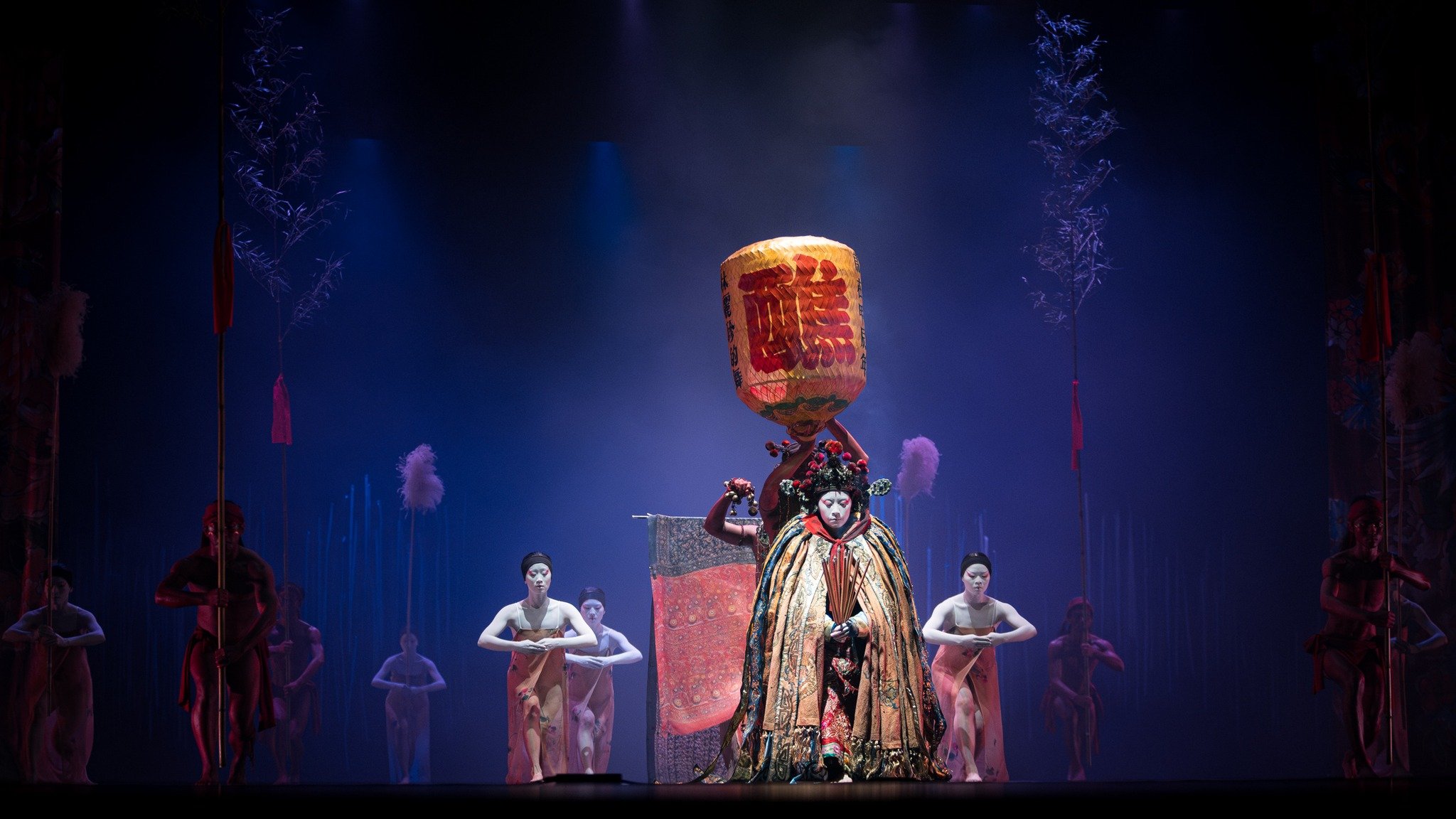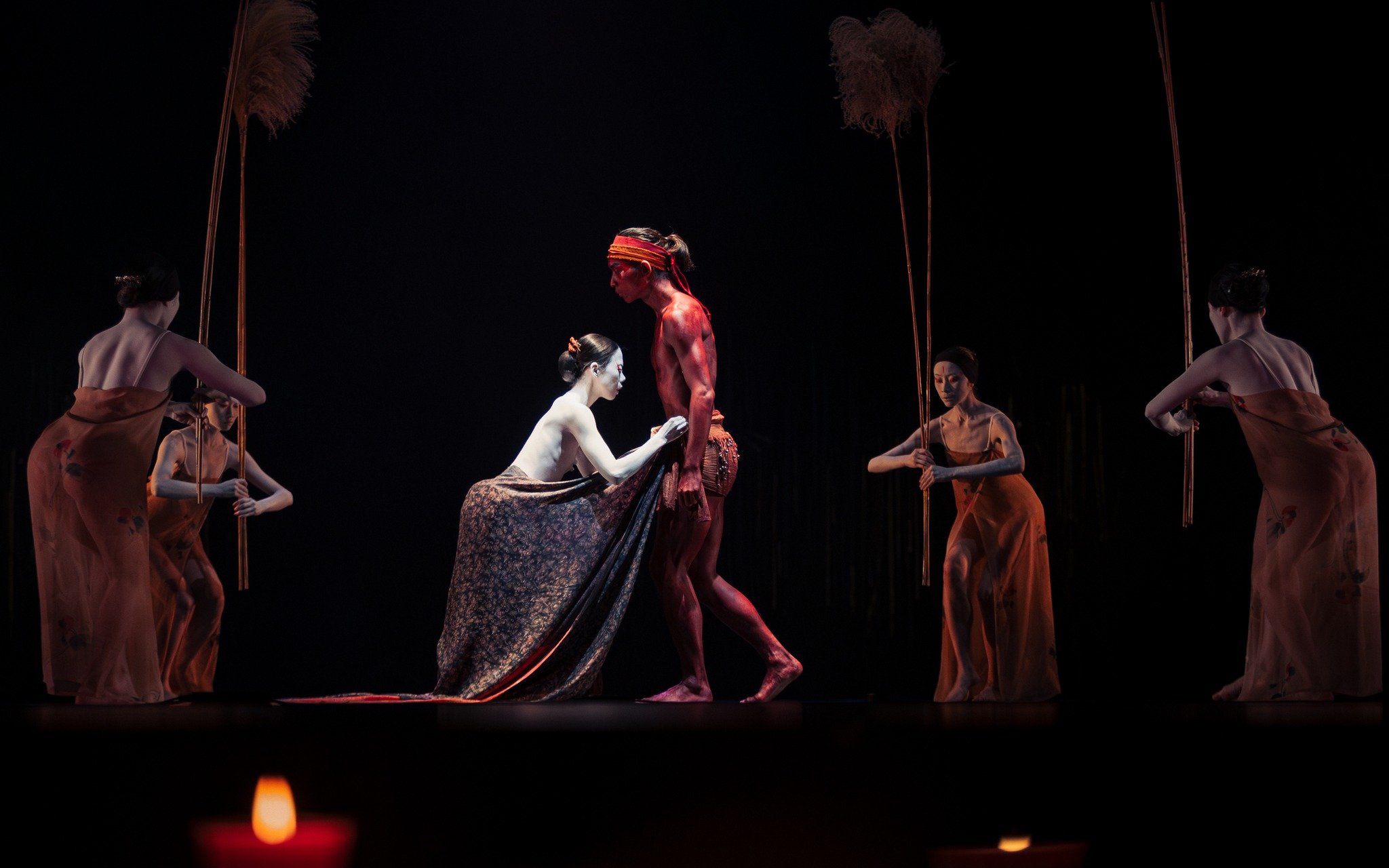Miroirs de Vie: Dance or Ritual?
30 years after its debut, Legend Lin Dance Theatre stages Miroirs de Vie, an artistic invocation that prays for the well-being of all during this time of uncertainty.
Sense of Wander: ★★★★☆
Stage design for the opening scene of “Miroirs de Vie” creates a ritualistic ambience.
TAIPEI, Taiwan — Attend any dance production by Legend Lin Dance Theatre and you’ll find yourself entering a trance-like state, where the experience of watching a dance performance turns into a meditation, but with open eyes.
Having had the privilege of watching Legend Lin Dance Theatre’s popular productions Song of Pensive Beholding (觀) and Anthem to the Fading Flowers (花神祭), I recently had the opportunity to witness Miroirs de Vie (醮), the first installment of the theatre’s Heaven-Earth-Human trilogy.
Upon entering the auditorium of National Theatre, I noticed lit candles placed on the stage before me. Seated in the centre of the second row, I could even smell the fragrance of the melting wax, setting the scene for a ritual that was about to unfold.
Miroirs de Vie was Legend Lin Dance Theatre’s inaugural production. Premiered at the National Theatre in 1995, this year marks the 30th anniversary of the company’s founding, and the work was brought back to the stage at its original venue.
The production’s Chinese title, “Jiao,” literally means “offering” or “sacrifice.” Today, one often associates “jiao” with large-scale ceremonies practiced by Taoists. Inspired by Taiwan’s folk religious rituals, whose origins trace back to Zhangzhou and Quanzhou provinces in southern China, Artistic Director Lin Lee-Chen integrated dance, Nanguan singing, folk religious themes, and Buddhist chants. This eclectic mix of elements, reminiscent of a Taoist ritual, made the experience feel akin to participating in a folk ceremony.
And unlike most dance productions, this “ritual” offered by Miroirs de Vie begins long before the lights are turned off in the auditorium. With lit candles scattered across the front stage, a group of dancers sit behind a screen that glistens like organza, chanting in a low but alluring rhythm.
Miroirs de Vie is divided into 12 sessions. First, a man dressed as a Taoist priest comes onstage, immediately transforming the stage into a sacred space. He performs rituals often seen inside a Taoist temple, such as sprinkling holy water from a cup around the altar to cleanse the area and wielding a sword in the air to ward off evils. Facing the audience while performing these rituals, it feels as if we — the audience — are the deities revered on the altar.
Like a religious procession, dancers advance from the back of the stage to the front, with the lead holds a bundle of incense in her hand. Image courtesy of Legend Lin Dance Theatre.
Then a beautiful scene emerges on stage. A parade, led by a woman dressed as a deity, slowly advances towards the audience. Above her head is a yellow lantern inscribed with the character “Jiao.” This parade, akin to a religious procession, highlights the theatre’s six-word philosophy: settle, calm, relax, ground, slow, and power. The result is an extremely slow, almost motionless movement imbued with ethereal qualities not found in other dance performances — a rare gem in a world obsessed with speed and efficiency.
The lead of the parade holds a bundle of incense in her hand, as one would when making an oblation to ancestors. Again, in that moment, I feel as if I’m the subject to which she’s paying tribute.
Like a religious procession, dancers advance from the back of the stage to the front, with the lead holding a bundle of incense in her hand. Image courtesy of Legend Lin Dance Theatre.
My attention is then captured by a muse who emerges gracefully from the midst of the parade, her body slowly unfolding from a delicate piece of textile, like a blossoming flower. I’m particularly struck by the elegance of her postures; every twist and turn, enhanced by the flowing fabric that adorns her, would make an excellent lock screen wallpaper.
After this mesmerising segment, a man appears on stage, engaging in a duo dance with the muse. Her snow-white body intertwines with his copper-tanned flesh. Despite their slow movements, palpable passion emanates from their union, perpetuated by the intimate contact of their skin and the exchange of their hormones.
This breathtaking segment, embodying Legend Lin Dance Theatre’s aesthetic philosophy, brims with juxtapositions: wild yet romantic, highly sensual yet subtle, entangled yet full of freedom. It’s worth noting that similiar duo scenes are also present in the other installments of the theatre’s Heaven-Earth-Human trilogy.
The highly sensual duo dance, emblematic of Legend Lin Dance Theatre’s aesthetic philosophy, marks the first climax of Miroirs de Vie. Image courtesy of Legend Lin Dance Theatre.
Following this evocative union, a scene unfolds where male dancers unleash their most primal nature. Their frenzied movements pave the way for the subsequent segment, titled “Possession.”
From the depths of the stage, a trio of male dancers emerges, embodying the experience of spirit possession, akin to a shaman (or “jitong” in Chinese) channeling spirits from higher realms. This process of inviting the spirits to inhabit their bodies is marked by noticeable shifts in their physical demeanour, which intensifies as they move closer to the audience.
With each step forward, their possessed behaviour escalates until the foremost dancer collapses onto the ground. “Is he now gone?” I wonder. Separated from the others by a partition, the man is further isolated from the audience by a screen, as if hinting at his transition into a liminal state within samsara, the eternal cycle of birth, death, and rebirth.
This particular segment, in my view, exemplifies Lin Li-Chen’s artistry in expressing her profound connection with Taiwan’s cultural landscape through choreography.
The segment “Possession,” where male dancers embody the role of shamans possessed by spirits, marks the second climax of Miroirs de Vie. Image courtesy of Legend Lin Dance Theatre.
Miroirs de Vie concludes with another procession, where dancers onstage carry what resembles a palanquin often seen in a religious procession. Typically, such palanquins house statues of deities for offerings along the path, accompanied by beating of drums, crashing gongs, and exploding firecrackers. When placed before us, it appears to be a temple.
Before the performance, the audience was invited to write down their prayers on strips of paper, which would be featured in this final scene. Despite the distance, I couldn’t help but wonder if my prayer — for humanity to be freed from all suffering — had found its place among the clusters of paper strips dancing in the backdrop.
Suddenly, the temple is set ablaze, possibly as a sacrificial act within the ritual that unfolds over nearly two hours. Before the flames can consume it entirely, the curtain falls, signaling the end of the ritual. Lingering in the air is the Buddhist chanting of the Prajnaparamita Mantra: “Gate Gate Paragate Parasamgate Bodhi Svaha.”
I couldn’t help but wonder if my prayer — for humanity to be freed from all suffering — had found its place among the clusters of paper strips dancing in the backdrop.
Miroirs de Vie concluded with another procession, where dancers onstage carried temple-like palanquin in a parade across the stage. Image courtesy of Legend Lin Dance Theatre.
To be honest, I was somewhat surprised that the performance came to an end before my emotional journey reached its peak. It wasn’t that the performance is lacking, but knowing the theatre’s aesthetics well, I was expecting more.
But as I was leaving the National Theatre, an unforeseen sense of calm and peace washed over me. It felt as though what I had just witnessed wasn’t merely a dance performance, but a ritual that cleansed my soul. It was then that the title of the production, Miroirs de Vie — meaning “Mirrors of Life” — truly resonated with me. As the ancient Greek philosopher Aristotle once remarked, what is presented on stage, inside a theatre, is ultimately a mirror of life.
While some may think that Miroirs de Vie cannot be compared directly to traditional theatrical productions, I would argue that the way it’s performed is undeniably theatrical. It evokes intense emotions akin to those experienced during a religious ritual: reverence, spiritual ecstasy, fear, submission, hope, and renewal. Leaving the theatre behind me, it was hope and renewal that lingered within me.
If you were to ask me whether I consider Miroirs de Vie a dance performance or a ritual, I would answer without hesitation: it’s an artistic invocation that cleanses and purifies the soul of its beholders, particularly in this time of uncertainty.
Legend Lin Dance Theatre staged Miroirs de Vie at the National Theatre in Taipei, Taiwan, from May 31 to Jun 2, 2024.






